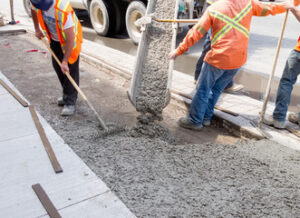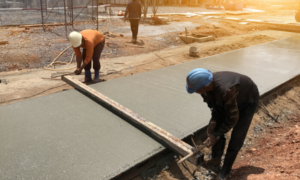A quality Concrete Contractors Dallas TX will always put a contract in writing. This helps ensure that all parties have a clear understanding of the project and will help avoid miscommunications later on.

Many concrete contractors have extensive experience in the field. This is often obtained by joining a cement mason’s union and going through an apprenticeship program with paid on-the-job training.
Creating a foundation for a building is an important job that requires a lot of skill and knowledge. This is especially true if you’re working on a large project, like a commercial or residential structure that will have heavy loads placed upon it on a regular basis. For this reason, a good concrete contractor will work to prepare the site before bringing in concrete form rentals and pouring concrete. Site preparation includes clearing the land, removing dirt and debris, assessing subsurface structures, evaluating underground utilities, and building a solid base for the concrete to be poured on.
A site plan is drawn up to indicate where the new construction will go, access roads for construction vehicles, storage areas for supplies, and any temporary buildings that will be needed. A surveyor can then assess the site to determine its topographical layout, set the precise location for foundations, and settle any disputes over land boundaries.
The next step in site preparation is earthwork, which consists of grading and leveling the ground. Excavation may also be needed, depending on the nature of the project. Clearing the land can involve removing trees, underbrush, and rocks. If the soil is too soft, it may require additional grading and filling to create a suitable building site.
Once the site is prepared, it’s time for concrete contractors to begin forming, pouring, and finishing the concrete work. Preparation is a key part of the construction process, and if it’s not done properly, the entire project can be derailed.
Concrete workers often learn their craft on the job, and a quality concrete contractor can work quickly to ensure that the project stays on schedule. They’ll take instructions from a foreman, and they’ll be able to handle a fast-paced environment without getting distracted or making mistakes that could lead to costly delays.
Formwork
Concrete contractors use formwork to mold concrete into walls, columns, slabs, staircases, and other building features. It’s a temporary structure that supports its own weight as well as the freshly placed concrete and construction live loads (materials, equipment, and workers).
Once the concrete contractor has reviewed the structural and architectural drawings of a project, they’ll choose a formwork system that either arrives in component parts or is already assembled. Workers then treat the inside surfaces of the formwork with a release agent—usually wax, oil, or plastic—to prevent the concrete from sticking to it as it sets.
To help ensure that the poured concrete takes its final shape and is supported, formwork must be properly fitted and securely tied to bearers and other structures on site. This is called forming, and it requires careful attention to detail to avoid errors that could lead to problems later on in the construction process.
The quality of the formwork is a significant factor in the overall cost of a project, as poorly constructed concrete can be difficult and costly to repair. It’s important that concrete forming contractors follow the engineering drawings and setup instructions for each piece of formwork. Rushing to save time or cutting corners can result in inaccurate work that will increase the cost of a project and threaten worker safety.
Once the formwork is in place, it’s time to start placing concrete! Using shovels and rakes, concrete workers move wet concrete into the shapes of the finished structure. This is an exciting and critical part of the process, as it’s when the concrete really begins to take its final shape. It’s important that the concrete is thoroughly consolidated and compacted to eliminate air pockets and reduce cracking, as well as finished with a smooth and even surface.
For large projects, the concrete must be allowed to set and harden before the formwork is removed. This typically takes about two days. If the formwork is removed too soon, the concrete will sag and lose its shape, which can have serious consequences for the entire structure. To help prevent this, the contractor must make sure that the formwork is thoroughly inspected and tested to confirm that it meets quality standards before removal.
Laying Concrete
Concrete contractors are able to handle the process of laying concrete from start to finish. They are specially trained and have the experience needed to mix the concrete correctly so that it is strong enough for the job at hand. They are also able to take measurements accurately so that the concrete isn’t too thick or too thin, which could cause it to crack or not be able to support weight.
They are able to use their skills, knowledge, and industry experience to create the best possible outcome for any job site. This means that they can suggest different options for homeowners and business owners to help them achieve their desired look. For example, they might suggest the use of concrete stamps to add an element of design to the finished product.
One of the key parts of their job is keeping supervisors and other construction crews updated on progress. This can be done by using project management software so that everyone has access to the information they need, regardless of where they are working. This helps ensure that the project is on schedule and prevents issues that may affect the final output.
In addition to updating other crews, concrete contractors will also need to keep their own supervisors informed about the progress of the work. This can be done by sending updates via text or email. However, some contractors prefer to use project management software because it allows them to track the progress of the work and share it quickly with other employees.
Once the concrete is poured, it needs to be leveled and smoothed out. This is when the concrete contractor can really show their expertise, as they will be able to create a perfectly smooth and even surface that is ready for the next stage of the process.
As a general rule, it is best to choose a concrete contractor that has been in business for a long time. This will give them the necessary level of experience to get the job done well and make sure that it is completed on time and within budget. It is also a good idea to check that they are licensed and insured, as this will protect you if anything goes wrong with your project.
Repairing Concrete
Concrete is tough stuff, but even the best installations eventually start to show signs of age. Cracks, chips, and other damage can make it look bad, and they can also weaken the structure and lead to further problems down the line if left untreated. Generally, repairing rather than replacing is the preferred option.
The first step is to evaluate the concrete and decide what needs to be fixed. This involves examining the concrete surface for any signs of failure, such as delamination, spalling, or surface contamination. The next step is to choose the right repair method for the job. This is based on the cause of the problem, which can be a simple crack or a long-term settlement issue.
Once the correct repair product has been chosen, the contractor needs to prepare the surface for the new concrete or patch mix. This usually involves a thorough cleaning with a brush or hose, followed by a light rinsing. Any unsound concrete should be chipped away with a hammer and chisel, and the area should be thoroughly rinsed to remove any remaining loose debris or stains.
Some contractors try to speed up the curing process by putting a heat lamp or fan on their work. However, this is not a good idea, as the strength of concrete relies on a natural chemical reaction between the cement and water that takes several days or weeks to complete. If this is cut short at all, the resulting concrete will not be strong enough.
It is also important to ensure the new concrete is compatible with the existing structure, according to ACI 546R-14. This means that the new concrete should have similar mechanical attributes to the original concrete, such as modulus of elasticity and permeability.
A precast concrete plant must develop and maintain a documented repair procedure for all of its products. This document should provide a way to share best practices and lessons learned with other employees, as well as help identify areas for improvement. This is an essential part of quality control, as it can improve the efficiency of production and reduce the risk of damaged products getting into the field.
